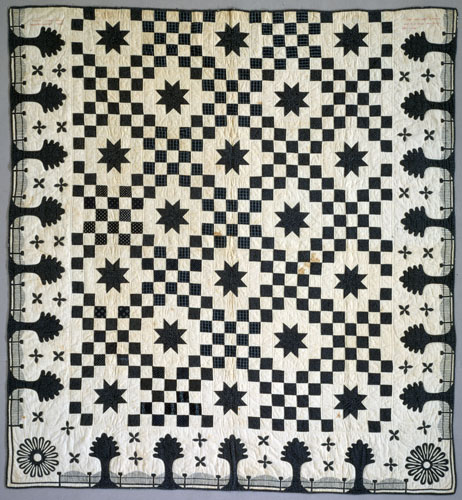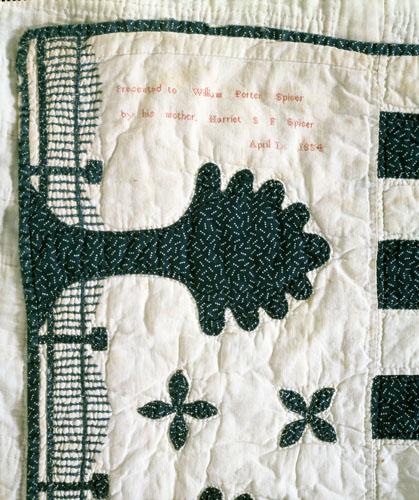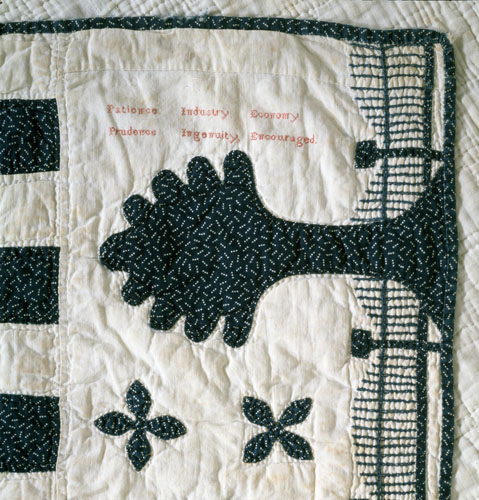
QUILT INDEX RECORD
25-21-340
Who documented this quilt?
Texas Sesquicentennial Quilt Association, Texas Quilt Search
Where are the records for this quilt housed?
Briscoe Center for American History, University of Texas at Austin
Texas Quilt Search Number:
tqs_0008
Person filling out this form is:
Quilt owner; Relative of quiltmaker; Other
Source of the information on this quilt:
This quilt was identified and reviewed during the Texas Sesquicentennial Quilt Association's Texas Quilt Search, 1983-1985. Karey Bresenhan served as quilt historian.
When was the form filled out?
1983-1985
Choose the best description of the source to the quilt:
Quilt owner
If you are the quilt owner, how did you acquire this quilt?
Inherited
Describe the relationship to the quilt's maker:
The present owner of this quilt is the great granddaughter of its maker.
This is a:
Finished quilt
Owner's name for quilt:
Double Irish Chain
How wide is the quilt?
69 in.
How long is the quilt?
74 in.
Shape of edge:
Straight
Shape of corners:
Straight
What color is the quilt?
Blue or Navy; White
Antique colors:
Indigo Blue
Overall color scheme:
Two color
Quilt's condition:
Good/moderate use
Damage:
Quilting thread broken or ties missing; Stains; Wear to edge or binding
Describe the damage:
water or possibly medicine stains
Notes on condition, damage, or repairs:
Embroidery intact and applique in good condition. In 1985, as part of the preparations for the “Lone Stars: A Legacy of Texas Quilts, 1836-1936” exhibit in the Texas Capitol Rotunda, the Texas Sesquicentennial Quilt Association sponsored a Quilt Conservation Seminar. Part of the seminar was a two-day intensive hands-on laboratory attended by quilt experts who stabilized, backed, or otherwise prepared the quilts, including this one, for this exhibition.
Type of inscription:
Date; Message; Signature
What is inscribed on the quilt?
At top right corner: "Patience, Industry, Economy, Prudence, Ingenuity, Encouraged" At top left corner: Presented to William Porter Spicer / by his mother, Harriet S F Spicer / April 1st 1854.
What is the date inscribed on the quilt?
1854
Method used to make the inscription:
Embroidery
Describe the method used to inscribe the quilt:
Cross stitched in red
Location of inscription:
other
Describe where the inscription was found:
corner
Time period:
1850-1875
When was the quilt finished?
1854
Family/owner's date for quilt:
1854
Date estimated by an antique dealer, quilt historian or appraiser:
1854
Who estimated the quilt's date?
Karey Bresenhan
Describe the quilt's layout:
Block pattern
Subject of the quilt:
overall design of blocks and stars bordered on three sides
Number of different block patterns used in the quilt:
Within the frame of fence posts and trees is the framed area of Double Irish Chain blocks in white and indigo print. Eighteen hand-pieced indigo print eight-pointed stars are on white blocks.
What is the shape of the quilt blocks?
Squares
Number of borders:
1 design border on three sides
Describe the borders:
An intricate border of print indigo blue on white field consisting of hand-appliqued fence posts with embroidered pickets and what appear to be hand-pieced palm trees, or perhaps rose or oak trees. There is a stylized cartouche, reverse appliqued, in the two bottom corners.
Fiber types used to make the quilt top:
Cotton
Fabric styles used in the quilt top:
Print; Solid/plain
Piecing techniques used to make the quilt top:
Hand Piecing
Applique techniques used to make the quilt top:
Hand Applique; Reverse Applique
Embellishment techniques used to make the quilt top:
Embroidery
Can you feel or see paper on the quilt that was used as a construction aid?
no
Materials used to make the back:
Cotton
What color is the back of the quilt?
White
Describe the back:
Same fabric used throughout; Solid/plain
Materials used in the quilt binding:
Cotton
Describe the binding:
same print indigo as on quilt front
How is the binding made?
Hand sewn; Home cut; Straight grain
What is the width of the binding (measure on the top only)?
less than a half inch
How thick is the quilt?
Thin (Less than 3/16?)
How are the layers held together?
Hand quilting
Thread type used for the quilting:
cotton
Color of thread used in the quilting:
white
Quilting designs used, overall motifs:
Outline
Describe the quilting designs used:
outline quilting around trees, cartouches, blocks; not heavily quilted
Features or notes about the quilt's appearance, materials, or construction:
Karey Bresenhan notes that this quilt, both in design and colors, has the look of early indigo-and-white woven coverlets. She sites a coverlet of a similar design, with fence, fence posts, and trees framing a center pattern, called Medallion with Rose Tree and Picket Fence (New York, 1842) pictured in America's Quilts and Coverlets.
Quilt top made by:
Spicer, Harriet Sophia Fyler
Quilted by:
Spicer, Harriet Sophia Fyler
Where the quilt was made, city:
Amboy
Where the quilt was made, state:
New York (NY)
Where the quilt was made, country:
United States
How was this quilt acquired?
Inheritance
Tell the story of how the quilt was obtained:
This quilt has passed through the quiltmaker's family. The quiltmaker made it for her first child, William Porter Spicer, who never married. He homesteaded in South Dakota in the 1880s, taking the quilt with him, then in 1913 moved with his brother to San Benito, Texas, as part of the land development movement in Texas's Rio Grande Valley. William Spicer, whom everyone called "Uncle Port," died during a flu epidemic in 1914, whereupon the quilt passed to his brother, the grandfather of the present owner Jean Brady Fox.
Describe anything about the history of the quilt that wasn't already recorded in a previous field:
The quiltmaker Harriet Sophia Fyler Spicer was born in 1820 in Sullivan, New York. She married in 1848, but eventually separated from her husband; she supported herself and her three children by quilting, weaving, and spinning. She made this quilt as a presentation quilt for her first-born son, William Porter Spicer. She began the quilt before William's birth and finished it two years after he was born. The present owner, Jean Brady Fox, stated that her Great Aunt Flora, the quiltmaker's daughter, said her mother called the quilt "Pennsylvania Around the Square."
Why was the quilt made?
Gift or presentation
The quilt was made to be used for:
Bedding, special occasion
Quilt is presently used as:
Keepsake/memento
Where did the maker get their materials?
Unknown
Where did the maker find their pattern?
Traditional pattern variation
Exhibitions where this quilt was displayed:
One of 62 Texas quilts exhibited in “Lone Stars: A Legacy of Texas Quilts, 1836-1936,” Texas State Capitol Rotunda, Austin, Texas, April 19-21, 1986.
Related items such as diaries, obituaries, wills, household inventories, or pictures of the quiltmaker:
Texas Sesquicentennial Quilt Association’s Texas Quilt Search Archives
Publications (including web sites) where this quilt or maker was featured:
Bresenhan, Karoline Patterson and Nancy O'Bryant Puentes, Lone Stars: A Legacy of Texas Quilts, Vol. I, 1836-1936 (Austin: University of Texas Press: 1986), p. 38-39.
Ownership of this quilt is:
Private
Quilt owner's name:
Fox, Jean Brady
Quilt owner's state:
Texas (TX)
Quilt owner's country:
United States
Quiltmaker's maiden name:
Fyler, Harriet Sophia
Quiltmaker's gender:
Female
Quiltmaker's birth date:
16/17/1820
Quiltmaker's birthplace, state:
New York
Quiltmaker's birthplace, country:
United States
Quiltmaker's marriage date(s):
01/09/1848
Quiltmaker's date and place of death:
03/06/1879
In which kind of environment did the quiltmaker live?
Urban
Quiltmaker's spouse's/spouses' and /or partner's/partners' name(s):
Spicer, [unknown]
Number of children:
3
How many of the quiltmaker's children were girls?
2
How many of the quiltmaker's children were boys?
1
Why does the quiltmaker quilt?
Gifts; Income
Notes on how the quiltmaker learned, and how and why they quilt:
Supported herself and three children in part by quilting for others, after separating from her husband
Does/did the quiltmaker sell quilts?
yes
Who photographed this quilt?
Sharon Risedorph
Access and copyright information:
Restricted
Copyright holder:
Assistant Director Winedale
Details
Cite this Quilt
Spicer, Harriet Sophia Fyle. Double Irish Chain. 1854. From Briscoe Center for American History, University of Texas at Austin, Texas Sesquicentennial Quilt Association, Texas Quilt Search. Published in The Quilt Index, https://quiltindex.org/view/?type=fullrec&kid=25-21-340. Accessed: 04/24/24
-
Essay
Lone Stars: A Legacy of Texas Quilts
Bresenhan, Karoline Patterson

